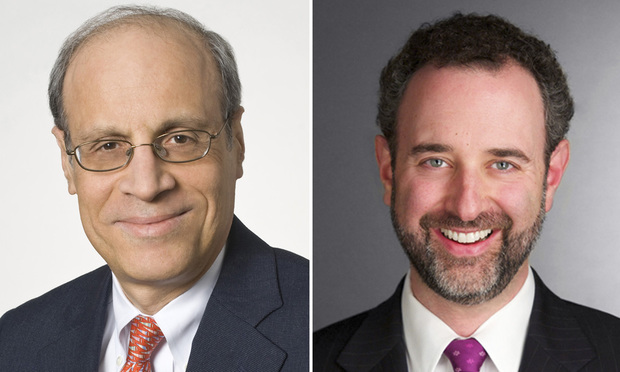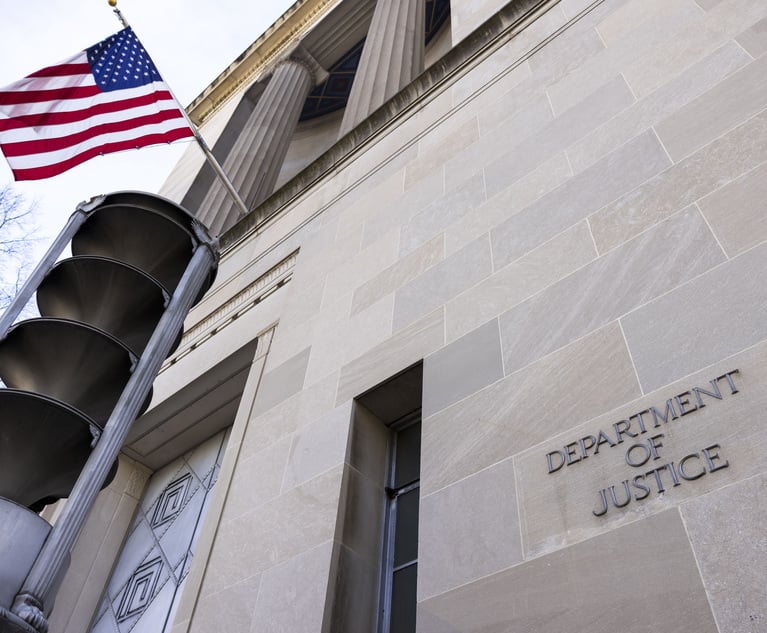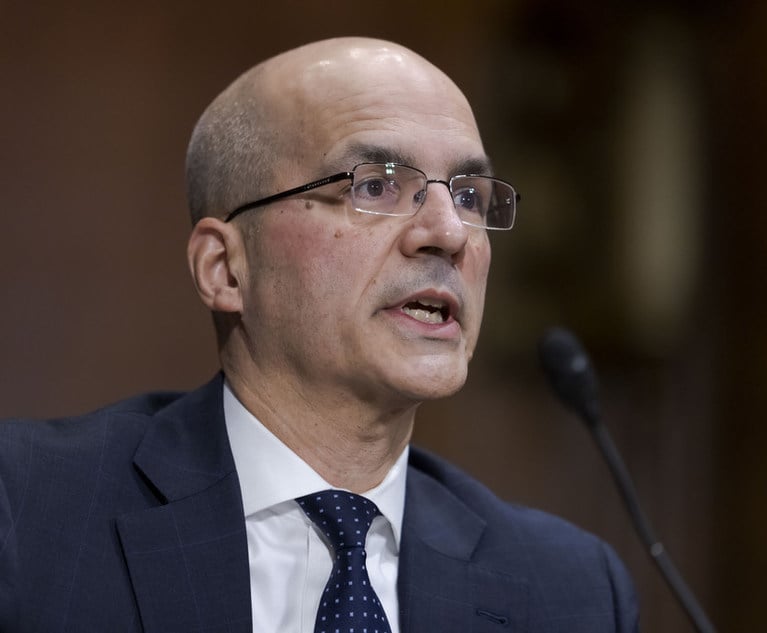Circuit Split on Trademark License Issue Heads to Supreme Court
Intellectual Property Litigation columnists Lewis R. Clayton and Eric Alan Stone write: This term, the Supreme Court in 'Mission Product Holdings v. Tempnology' is set to resolve a circuit split over whether a trademark licensee may continue to use licensed marks where the licensor, as a debtor-in-possession in a bankruptcy proceeding, rejects the license agreement. They discuss the case and the decisions in other circuits.
January 08, 2019 at 02:45 PM
9 minute read
 Lewis R. Clayton and Eric Alan Stone
Lewis R. Clayton and Eric Alan Stone
This term, the Supreme Court in Mission Product Holdings v. Tempnology, is set to resolve a circuit split over whether a trademark licensee may continue to use licensed marks where the licensor, as a debtor-in-possession in a bankruptcy proceeding, rejects the license agreement. No. 17-1657 (U.S.).
In In re Tempnology, the First Circuit held that where a debtor-in-possession licensor rejects a license agreement, the licensee may no longer use the licensed trademarks, and may instead claim damages. See 879 F.3d 389 (1st Cir. 2018). In so holding, the First Circuit followed Fourth Circuit precedent, see Lubrizol Enterprises v. Richmond Metal Finishers, 756 F.2d 1043 (4th Cir. 1985), and declined to follow Seventh Circuit precedent allowing the licensee to continue to use the marks after the licensor's rejection of the agreement, see Sunbeam Products v. Chicago American Manufacturing, 686 F.3d 372 (7th Cir. 2012).
We report here on these decisions and on the pending appeal of the First Circuit's Tempnology decision.
Bankruptcy Code and the Role of Trademarks in 'Intellectual Property'
Section 365 of the Bankruptcy Code generally permits a bankruptcy trustee, “subject to the court's approval,” to “assume or reject any executory contract or unexpired lease of the debtor.” 11 U.S.C. §365(a). Such a rejection “constitutes a breach of such contract or lease,” 11 U.S.C. §365(g), and the debtor's unfulfilled obligations give rise to a claim for damages, see Sunbeam, 686 F.3d at 377.
In 1988, Congress added intellectual-property-specific provisions to these general rules. Specifically, §365(n)(1) provides that where the rejected contract is one “under which the debtor is a licensor of a right to intellectual property,” the licensee may “elect … to retain its rights … under such contract and under any agreement supplementary to such contract, to such intellectual property … as such rights existed immediately before the case commenced.”
The definitional section, in turn, was amended to define “intellectual property” as used in §365. See 11 U.S.C. §101(35)(A). The definition listed trade secrets, patents and patent applications, and copyrighted works of authorship, but was silent as to trademarks.
The omission was clear to Congress at the time, as the legislative history notes that “the bill does not address the rejection of executory trademark[s], … such contracts raise issues beyond the scope of this legislation . … Since these matters could not be addressed without more extensive study, it was determined to postpone congressional action in this area and to allow the development of equitable treatment of this situation by bankruptcy courts.” S. Rep. No. 100-505, at 5 (1988).
The circuit split turns on the significance of the omission of trademarks from this definition.
Fourth Circuit's 'Lubrizol' Decision
Lubrizol preceded the intellectual-property provisions by three years. There, the Fourth Circuit held that by rejecting a nonexclusive patent license agreement to certain metal-coating technology, the trustee terminated the patent license. 756 F.2d at 1048. The Fourth Circuit held that under then-existing §365(g), while the termination of the patent license in bankruptcy constituted breach by the licensor, the licensee's only remedy for that breach was money damages. The court reasoned that “[a]llowing specific performance would obviously undercut the core purpose of rejection under §365(a), and that consequence cannot therefore be read into congressional intent.” Id. The court found that a money-damages-only remedy was consistent with the purpose behind the enactment of §365: “the legislative history of §365(g) makes clear that the purpose of the provision is to provide only a damages remedy for the non-bankrupt party.” Id. The court declined to address equitable considerations of harm to the licensee, because “under bankruptcy law such equitable considerations may not be indulged by courts in respect of the type of contract here in issue. Congress has plainly provided for the rejection of executory contracts, notwithstanding the obvious adverse consequences for contracting parties thereby made inevitable.” Id.
Seventh Circuit's 'Sunbeam' Decision
By the time the Sunbeam case reached the Seventh Circuit, Congress had enacted §365(n), permitting “intellectual property” licensees to elect to continue their rights under otherwise-rejected agreements, and had enacted the definition of intellectual property that did not include trademarks.
Faced with the trustee's rejection of a trademark license, the Seventh Circuit held that the licensee could elect to continue to use the marks even though the trustee had rejected the license agreement in bankruptcy. See 686 F.3d at 376.
The court analogized the rejection of a license agreement in bankruptcy—which §365(g) classifies as a breach of that agreement—to a breach outside the bankruptcy context. The court pointed out that “[o]utside of bankruptcy, a licensor's breach does not terminate a licensee's rights to intellectual property,” meaning that the licensor “could not have ended [licensee's] right to sell the box fans by failing to perform its own duties.” Id. at 376-77. Thus, according to the court, “nothing about [the rejection process] implies that any rights of the other contracting party have been vaporized.” Id. at 377.
Notably, like the Fourth Circuit, the Seventh Circuit refused to take into account equitable considerations to support its holding that the license to the mark was not terminated by rejection: “Rights depend, however, on what the [Bankruptcy] Code provides rather than on notions of equity.” Id. at 376.
First Circuit's 'Tempnology' Decision
The Tempnology case involves trademarks for athletic equipment—socks and towels—that stay cool even when used during exercise. In bankruptcy, Tempnology rejected its prior license to Mission, which had allowed Mission to use certain of Tempnology's trademarks. The First Circuit, following Lubrizol, held that Tempnology's rejection of the license agreement “left Mission with only a pre-petition damages claim,” and that Tempnology had no obligation “to further perform under” the trademark license. 879 F.3d at 392.
The court reasoned that allowing a licensee to continue using a licensed mark after the licensor's rejection of the license agreement would frustrate the bankruptcy purpose of rejection: “Congress's principal aim in providing for rejection was to 'release the debtor's estate from burdensome obligations that can impede a successful reorganization.' … [T]he effective licensing of a trademark requires that the trademark owner … monitor and exercise control over the quality of goods sold to the public under cover of the trademark.” Id. at 402. According to the court, if Mission could keep using Tempnology's marks, that implied “restriction” on Tempnology's “ability to free itself from its executory obligations, even if limited to trademark licenses alone, would depart from the manner in which section 365(a) otherwise operates.” Id. at 403.
The First Circuit also criticized the Seventh Circuit's approach, holding that “Sunbeam entirely ignores the residual enforcement burden it would impose on the debtor just as the Code otherwise allows the debtor to free itself from executory burdens. The approach also rests on a logic that invites further degradation of the debtor's fresh start options.” Id. at 404. Thus, the Tempnology court “favor[s] the categorical approach of leaving trademark licenses unprotected from court-approved rejection, unless and until Congress should decide otherwise.” Id.
The First Circuit did agree, however, with both the Seventh Circuit and the Fourth Circuit that equitable considerations should not be part of the analysis. Id. at 401.
The Supreme Court Appeal
The Supreme Court granted Mission's petition for certiorari on Oct. 26, 2018.
Mission argues that Tempnology's repudiation of its license agreement in bankruptcy should not confer additional rights beyond those that breach would confer outside of bankruptcy. Mission analogizes the license agreement to a lease of real property, and argues that “[o]utside bankruptcy, a landlord that breaches a lease … does not thereby acquire the right to evict the tenant. The same is true in bankruptcy.” 2018 WL6584717, at *4. Thus, according to Mission, “No one contends that, outside bankruptcy, Tempnology's breach of the license agreement would have permitted it to revoke the license. Rejection of the license agreement in bankruptcy does not entitle Tempnology to anything more.” Id.
Mission also responds to the First Circuit's reasoning that continued use of a mark would place a burden on debtors, arguing that “rejection frees the estate only from the burden of performing under contracts; it does not exempt the estate from duties imposed by generally applicable law. Whether the estate should incur the cost of monitoring to preserve the value of a trademark is an economic decision no different than any of the trustee's many other decisions whether to incur costs to preserve estate assets.” Id. at *15 (emphasis omitted).
Tempnology has not yet filed its merits brief. In its opposition to Mission's petition for certiorari, Tempnology argued that “the First Circuit properly recognized that trademarks are different from other intellectual property rights, and that the Bankruptcy Code's strong policy of permitting a debtor to free itself of ongoing obligations under a contract as embodied in section 365(a) and the right to reject such obligations applies to the burden of policing trademarks.” 2018 WL 4275886, at *2.
Tempnology also argued that Congress's intent is clear, such that Congress “deliberately chose not to include trademarks” when it extended protection to licensees of, for example, patents and trade secrets. Id. at *3.
Oral argument is scheduled for Feb. 20, 2019. The court will likely issue a ruling by June of this year.
Lewis R. Clayton and Eric Alan Stone are litigation partners at Paul, Weiss, Rifkind, Wharton & Garrison. Michael F. Milea, an associate at the firm, assisted in the preparation of this column.
This content has been archived. It is available through our partners, LexisNexis® and Bloomberg Law.
To view this content, please continue to their sites.
Not a Lexis Subscriber?
Subscribe Now
Not a Bloomberg Law Subscriber?
Subscribe Now
NOT FOR REPRINT
© 2025 ALM Global, LLC, All Rights Reserved. Request academic re-use from www.copyright.com. All other uses, submit a request to [email protected]. For more information visit Asset & Logo Licensing.
You Might Like
View All
'A Shock to the System’: Some Government Attorneys Are Forced Out, While Others Weigh Job Options
7 minute read
'Serious Legal Errors'?: Rival League May Appeal Following Dismissal of Soccer Antitrust Case
6 minute read
How Some Elite Law Firms Are Growing Equity Partner Ranks Faster Than Others
4 minute read
Trending Stories
- 1'Translate Across Disciplines': Paul Hastings’ New Tech Transactions Leader
- 2Milbank’s Revenue and Profits Surge Following Demand Increases Across the Board
- 3Fourth Quarter Growth in Demand and Worked Rates Coincided with Countercyclical Dip, New Report Indicates
- 4Public Notices/Calendars
- 5Monday Newspaper
Who Got The Work
J. Brugh Lower of Gibbons has entered an appearance for industrial equipment supplier Devco Corporation in a pending trademark infringement lawsuit. The suit, accusing the defendant of selling knock-off Graco products, was filed Dec. 18 in New Jersey District Court by Rivkin Radler on behalf of Graco Inc. and Graco Minnesota. The case, assigned to U.S. District Judge Zahid N. Quraishi, is 3:24-cv-11294, Graco Inc. et al v. Devco Corporation.
Who Got The Work
Rebecca Maller-Stein and Kent A. Yalowitz of Arnold & Porter Kaye Scholer have entered their appearances for Hanaco Venture Capital and its executives, Lior Prosor and David Frankel, in a pending securities lawsuit. The action, filed on Dec. 24 in New York Southern District Court by Zell, Aron & Co. on behalf of Goldeneye Advisors, accuses the defendants of negligently and fraudulently managing the plaintiff's $1 million investment. The case, assigned to U.S. District Judge Vernon S. Broderick, is 1:24-cv-09918, Goldeneye Advisors, LLC v. Hanaco Venture Capital, Ltd. et al.
Who Got The Work
Attorneys from A&O Shearman has stepped in as defense counsel for Toronto-Dominion Bank and other defendants in a pending securities class action. The suit, filed Dec. 11 in New York Southern District Court by Bleichmar Fonti & Auld, accuses the defendants of concealing the bank's 'pervasive' deficiencies in regards to its compliance with the Bank Secrecy Act and the quality of its anti-money laundering controls. The case, assigned to U.S. District Judge Arun Subramanian, is 1:24-cv-09445, Gonzalez v. The Toronto-Dominion Bank et al.
Who Got The Work
Crown Castle International, a Pennsylvania company providing shared communications infrastructure, has turned to Luke D. Wolf of Gordon Rees Scully Mansukhani to fend off a pending breach-of-contract lawsuit. The court action, filed Nov. 25 in Michigan Eastern District Court by Hooper Hathaway PC on behalf of The Town Residences LLC, accuses Crown Castle of failing to transfer approximately $30,000 in utility payments from T-Mobile in breach of a roof-top lease and assignment agreement. The case, assigned to U.S. District Judge Susan K. Declercq, is 2:24-cv-13131, The Town Residences LLC v. T-Mobile US, Inc. et al.
Who Got The Work
Wilfred P. Coronato and Daniel M. Schwartz of McCarter & English have stepped in as defense counsel to Electrolux Home Products Inc. in a pending product liability lawsuit. The court action, filed Nov. 26 in New York Eastern District Court by Poulos Lopiccolo PC and Nagel Rice LLP on behalf of David Stern, alleges that the defendant's refrigerators’ drawers and shelving repeatedly break and fall apart within months after purchase. The case, assigned to U.S. District Judge Joan M. Azrack, is 2:24-cv-08204, Stern v. Electrolux Home Products, Inc.
Featured Firms
Law Offices of Gary Martin Hays & Associates, P.C.
(470) 294-1674
Law Offices of Mark E. Salomone
(857) 444-6468
Smith & Hassler
(713) 739-1250






